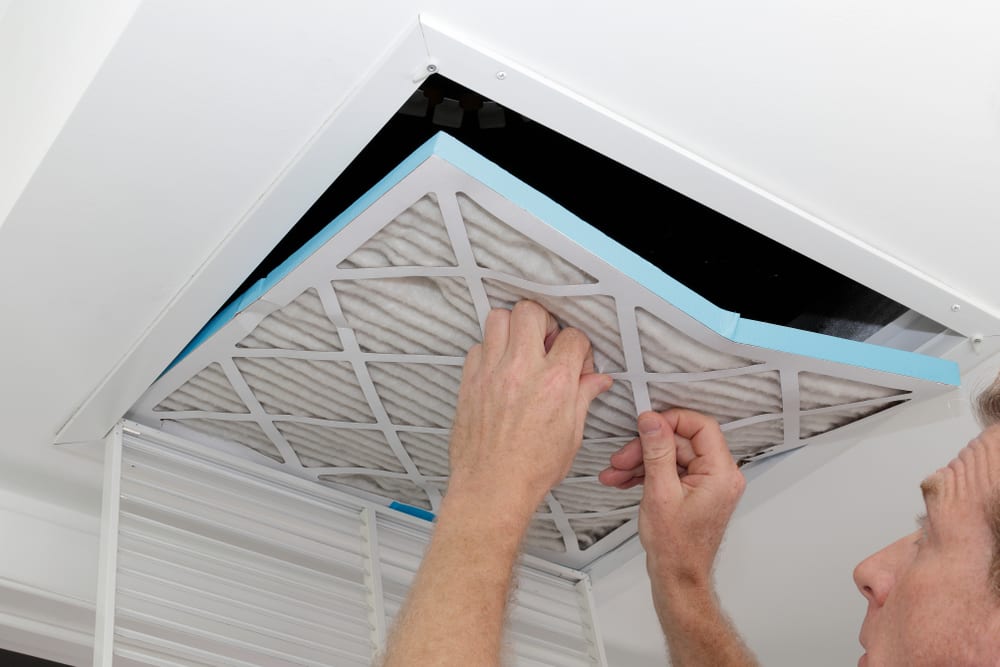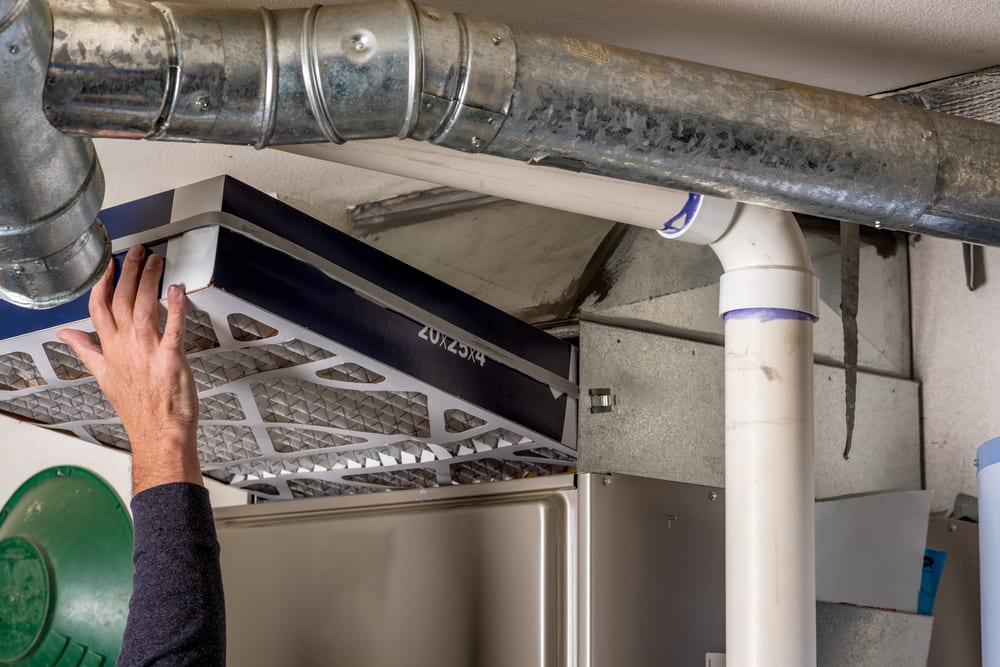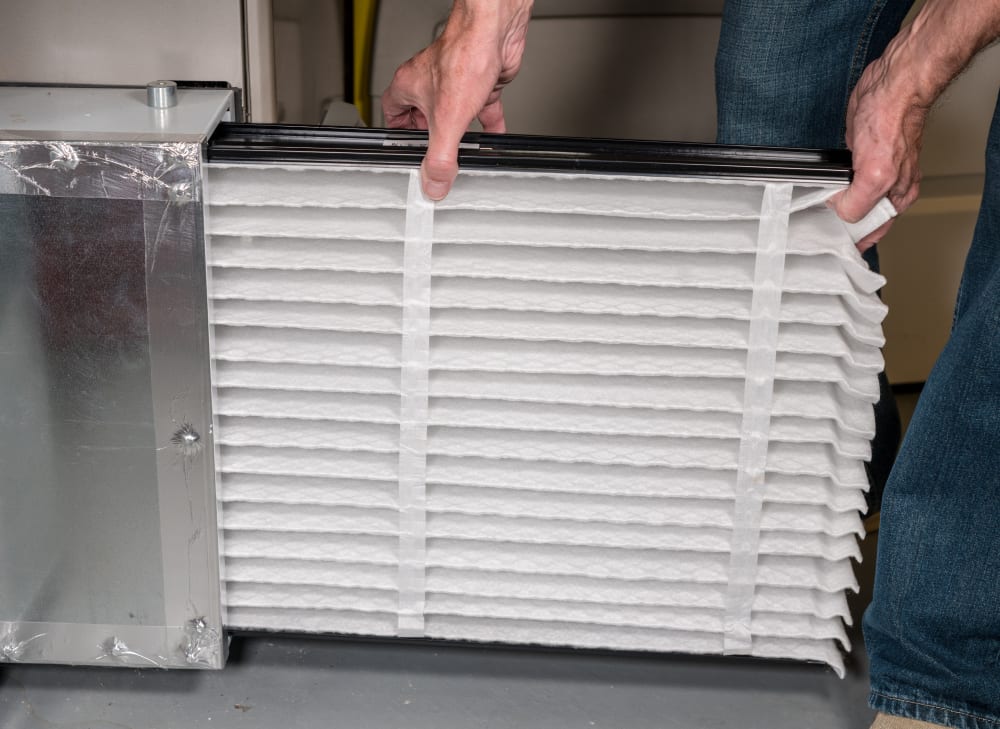INDOOR AIR QUALITY SERVICES IN FLORIDA
Whole-House Air Filtration Systems
Today we spend more time indoors – at work, gyms, and our own homes – than we do outside. Recent health restrictions have only increased our time in conditioned spaces. We offer whole-house air purifiers to homes in Jacksonville and other areas of Florida. Our team offers ultraviolet light air purification systems, ionizing air filters, electrostatic air filtration units, and HEPA air filters that are designed to eliminate contaminants from the air in your house. Give our team a call by phone at (904) 217-5694 to become familiar with our indoor air quality services.
Stop and Think: How Clean is the Air We Breathe Indoors?
A recent report by the Environmental Protection Agency revealed that the air quality inside the average home is five times worse (full of dander, pollen, dust mites, and other irritants) than the air outside! Fenwick Home Services offers whole-home air filtration systems such as the Phenomenal Aire Cold Plasma Generator (CPG) to keep your home and family healthy.
Phenomenal Aire CPG is a revolutionary air purification technology that Deactivates 99.9% of Coronavirus* particles and reduces other viruses and contaminates from your home for fresher, cleaner and SAFER air with every breath.
What is Indoor Air Quality (IAQ)
Indoor Air Quality (IAQ) refers to the air quality within and around buildings and structures, especially as it relates to the health and comfort of building occupants. Indoor air quality can be a major problem for homeowners but understanding and controlling common pollutants can help reduce your risk of indoor health concerns.
Common Examples of Indoor Pollutants Include
- Indoor Dust and Pet Dander AllergensDust mites are microscopic bugs that live in carpet, bedding, upholstery, stuffed toys, and bedding. These bugs are invisible to the human eye but can majorly impact health. This is especially true for those already at risk, like the young, elderly, or those with allergies or asthma. Relatively minor effects include coughing, wheezing, and discomfort. At the same time, more severe implications can require medication or even hospitalization.Dander (dead skin cells sloughed off an animal’s coat) is the most common source of pet allergies. Pet dander clings to surfaces and makes its way into household cracks and crevices. Unfortunately, dander can linger for months in carpets, furniture, and even bedding!The result includes a variety of health issues for allergy sufferers.Frequent cleaning at home – including vacuuming, frequent bedding changes, and wiping down surfaces – helps keep these pollutants at bay. Use a vacuum cleaner with a HEPA filter to reduce dust and pet dander concentrations in your home. A HEPA filter can also eliminate other toxins, including lead.
- Volatile Organic Compounds (VOCs)Volatile Organic Compounds (VOCs) are toxic airborne chemicals emitted as gases from certain solids or liquids. Top sources of VOCs in the home include paints, aerosol sprays, and air fresheners, pesticides, dry-cleaned clothing, and cleansers. Once airborne, these particles pose short and long-term health effects. According to the EPA, VOCs often cause eye, nose, throat irritation, nausea, and damage to the liver, kidney, and central nervous system.
- Bacteria, Germs, and VirusesPoor indoor air quality can increase the risk of spreading highly contagious viruses like the cold and flu. More severe viruses, such as Coronavirus (COVID-19), are also a threat. Viruses are microscopic pathogens that need hosts to thrive. Once a virus enters the body, it begins to hijack healthy cells and reproduce at a significant pace. Bacteria or germs thrive in enclosed spaces and spread quickly through the air. Most bacteria are harmless. However, some strains of bacteria produce toxins that can kill cells and damage the immune system.
Indoor Air Pollutants May Cause Serious Health Concerns, Such As:
- Nausea
- Dizziness
- Fatigue
- Sneezing
- Coughing
- Eye and skin irritations
- Congestion
- Headaches
- Allergic reactions
- Respiratory tract infections
- Asthma
The EPA states that indoor air is one of the top five environmental health risks of our time. In fact, indoor air has been found to contain up to 60 times more pollutants than outdoor air. A recent study by the American College of Allergist & Asthma states that polluted indoor air is the root cause of 40% – 50% of all illnesses.
 How to Test the Air Quality in Your Home
How to Test the Air Quality in Your Home
Eliminating individual sources of pollution in the home can reduce indoor air pollutant concentrations and reduce emissions. Harmful pollutants may come from faulty appliance emissions, such as stoves or furnaces. Two out of three indoor air quality issues involve the poor performance and improper functioning of your HVAC (Heating Ventilation Air Conditioning) system. That’s why it’s crucial for a thoroughly trained technician to evaluate your home equipment annually.
Improving Your Indoor Air Quality Can Begin With Tests for Key Pollutants Known to Impact Health:
- Test for Lead
Homes built before 1978 can benefit from a lead test, as most indoor and outdoor paints were lead-based before that time. Lead dust brought in from outside sources may also affect air quality in newer homes. Lead dust can be especially detrimental to children’s health in the home and may damage the brain, central nervous system, and kidneys.Use a vacuum cleaner with a HEPA filter to reduce concentrations of lead in your home. A HEPA filter can also eliminate toxins. The Environmental Protection Agency offers practical suggestions on how to make your home lead-safe.
- Test for Radon
Homeowners are encouraged to test for radon. Radon is a colorless, odorless, radioactive gas that typically moves up through the ground and into living spaces through cracks, gaps, or holes in the foundation. However, even airtight homes can potentially have it, and granite counter tops have also been linked to radon. Radon gas is prevalent in some areas due to uranium deposits in the rock strata. Uranium off-gases radon as a by-product of mining activities.The good news is that in-home radon testing is easy, reasonably inexpensive, and takes only a few minutes to complete.A radon test is highly recommended, as radon is the second leading cause of cancer in the United States according to the American Lung Association. In some cases, radon testing is required by certain lending institutions before the transfer of a property.Rest assured that with proper remediation equipment, even high radon levels can be reduced to acceptable levels.Please go to https://www.city-data.com/radon-zones/ to see what the average radon levels are in your neighborhood.
- Test for Carbon Monoxide
Carbon monoxide (CO) is known as “The Silent Killer” in your home. Like radon, carbon monoxide is a toxic odorless, tasteless and colorless gas. A buildup of CO in the home can lead to carbon monoxide poisoning or, in extreme cases, death. CO can come from any device that burns fuel such as your furnace, water heater, stove, and dryer if they are not in good working condition or have not been installed with proper ventilation.Symptoms of someone experiencing CO poisoning can range from shortness of breath, mild nausea, and mild headaches to dizziness, mental confusion, severe headaches, and even death.Since carbon monoxide does not have characteristics such as odor to alert you, the best way to keep your family aware of unsafe levels is to install carbon monoxide detectors throughout the house. A carbon monoxide alarm constantly samples the air, monitors for the presence of CO, and sounds an alarm when CO is detected at dangerous levels.A Fenwick HVAC technician can service your furnace annually to prevent problems, such as carbon monoxide poisoning. - Test for Mold
Testing for mold spores in the air can be as simple as purchasing a mold test kit. Dust mites and mold love moisture. A healthy level of humidity at around 30%-50% will help keep your home free from mold and other allergens under control. Using a dehumidifier and air conditioner during the summer months will help reduce moisture in indoor air and effectively control allergens. An efficient air conditioner will also lower indoor pollen count.As a side note, modern high-efficiency central air conditioning systems have intelligent thermostats that tell fans to ramp up or down, depending on particular needs, thus controlling humidity levels better than ever. Make sure your leaky plumbing gets repaired to prevent mold. From small portable table-top air cleaners to whole-house systems, there are many tools to help make your IAQ healthier.
 Indoor Air Quality Services
Indoor Air Quality Services
As well as installing the Phenomenal Aire Purification System, our certified and licensed HVAC technicians are extensively trained to assess poor air quality and install advanced air filtration systems to enhance the quality of your air and restore the health of your home. Preventative maintenance is the first step in evaluating and controlling your indoor air quality.
Our Air Filters, Humidifiers & Other Solutions Can Help You Feel Better
- UV Air Purifier: This system will destroy and reduce potentially harmful contaminants
- Humidifiers and Dehumidifiers: A dehumidifier operates with your HVAC system to keep moisture levels balanced throughout your home
- Air Filters: These capture even the smallest contaminants and keep them from recirculating back into the home’s air
- Air Purification System: Contaminants are removed and destroyed by the air purification system before air is recirculated in the home
If you continue not feeling well, and have more dust and dirt in your home than you need, call us and make an appointment with one of our indoor air specialists. With our extensive training and experience, we will inspect your house and recommend a whole-house air purifier to meet your needs.
We also offer other HVAC services such as furnace repair, air conditioning installation, furnace replacement, and air conditioning repair. We use the latest tools to help determine the quality of your indoor air and can provide you with the products and services you need to improve your IAQ levels.
 4 Types of Air Purification Systems for Homes
4 Types of Air Purification Systems for Homes
UV-Light Purifier System
Ultraviolet (UV) light is commonly used to disinfect water, surfaces, and air. Whole-house UV air purification systems are becoming popular in homes to kill airborne pathogens, mold, bacteria, and viruses. The system is designed to utilize short-wave ultraviolet light to inactivate pathogens and microorganisms. Usually, these systems are freestanding devices, but they can also be installed into pre-existing HVAC systems. As the air is circulated through the air filtration system, it passes under UV lamps, where germicidal irradiation occurs. Ozone may be a by-product of this process. Although a freestanding UV-light air purifier system can extract viruses and contaminants, it is not as effective as a whole-house UV-light filtration system.
Ionizing Air Filters
There are types of air filtration systems that come with a built-in ionizer. These ionizing air filters utilize energy to distribute a negative electrical charge to particles and contaminants in the air. This electrical charge will cause the particles to be removed from the air. Installing an ionizing air filter to your furnace is a fast way to improve the quality of your air.
How an Ionizing Air Filter Operates
The molecules that circulate the negative charge are referred to as ions. Once an ion reaches a particle in the air, it will integrate with the particle to emit a negative charge. Next, the negative charge will cause the contaminants to become attracted to other particles in the air. Once the contaminants become attracted to particles of the opposite charge, they will start to cluster together to form heavy particles that fall to the ground or other surfaces.
On the other hand, the negative particles may become attracted to surfaces with a positive charge such as clothes, carpet, or rugs. An ionizing air filtration system can be connected to the blower fan in your furnace to circulate contaminated air through a filter. However, other types of ionizing air purifiers are not integrated with a fan and utilize wind currents to extract contaminants. In addition, an ionizer can be connected to a HEPA air filtration system to remove miniature particles in the air.
HEPA Air Filtration System
HEPA stands for “high-efficiency particulate air.” The key to the effectiveness of a HEPA air filtration system is its pleated layers of individual filters. Each filter traps harmful particles. The final filter allows only cleaned air to go through. This type of filter is assembled with a mixture of glass fibers that are tangled in a variety of angles. Each of the fibers in the filter is designed to extract 99.97% of contaminants in the air that are 0.3 microns or larger.
Small Particles & Contaminants
The glass fibers in a HEPA air filter are intertwined to stop small particles when they travel through the filter. Unlike large particles that travel through the air in a straight line, miniature particles are circulated at a fast and random rate. As a small particle is distributed through the HEPA air filter, it will move in random directions and become stuck to a glass fiber. In addition, a HEPA whole-house air purifier is engineered to remove medium sized particles before the air reaches your air ducts.
Once a medium-sized particle enters the air filter, it will start to navigate around the fibers. Although these medium particles are able to pass through a couple of fibers, it will eventually become stuck when it encounters a fiber that is smaller than the particle. A HEPA air filtration system will remove each of the particles before they are disbursed to each room in your house.
Large Contaminants
The glass fibers in a HEPA air filter are compressed together in a tight manner to block types of contaminants such as mold, dust, and pollen. Since particles such as dust and mold are larger when compared to the gaps between two fibers, large particles will bump into the threads and become struck. Investing in a HEPA air filtration system is an excellent way to alleviate allergies.
Electrostatic Air Filters
Electrostatic air filters are rectangular and about 1-inch thick. They are reusable and come fitted in an aluminum frame. Like the HEPA air filter, this type of filter has several layers. A whole-house electrostatic air purifier can successfully trap dirt and dust. In addition, an electrostatic filter is designed to extract viruses in the air because of its unique blend of polyurethane and polypropylene materials. When air passes through this material, it generates strong static electrical charges. These static charges are negative, which help attract positively charged particles, like dust and mold. The negative charge of the electrostatic air filter will trap and store the airborne contaminants until they are cleaned.
Here Are Additional Resources to Identify, Correct, and Prevent IAQ Problems:
- HVAC products and accessories for whole-home comfort
- Read more expert tips and information on Indoor Air Quality
- Find Indoor Air Quality Testing and Services in Your Area
If you continue not feeling well, and have more dust and dirt in your home than you need, call us and make an appointment with one of our indoor air specialists. With our extensive training and experience, we can usually make recommendations with just an inspection of your home.
We also offer other HVAC services such as furnace repair, air conditioning installation, furnace replacement, and air conditioning repair. We use the latest tools to help determine the quality of your indoor air and can provide you with the products and services you need to improve your IAQ levels.
Let’s Talk About the Health of Your Air at Home
Frequent coughing, increased allergy issues, or frequent bouts of illness are the first sign the air quality in your home needs help. Noticeable dust and dirt in your home is another sign you need an IAQ plan! No matter what your indoor air quality challenge is, call now for an indoor air quality assessment by Fenwick Home Services. We offer HEPA air purifier systems, electrostatic air filters, and ultraviolet light air filtration systems to homes in Florida.
Our team of licensed technicians can travel to areas of Florida such as Orange Park, St. Augustine, Jacksonville, and Fleming Island. We also offer other HVAC services such as furnace repair, air conditioning installation, furnace replacement, and air conditioning repair. We use the latest tools to help determine the quality of your indoor air and can provide the insight, products, and services you need to improve your IAQ levels.
What Is Indoor Air Quality?
How Can I Improve My Indoor Air Quality?
What Are The Benefits of Clean Air?
Can Indoor Air Be Hazardous To My Health?
We offer reliable indoor air quality services to homes in Florida. Give our team a call by phone at (904) 217-5694 to schedule an appointment with our team.

